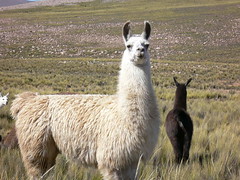Off to Bolivia
Tomorrow I leave for a three-day tour to the Salar de Uyuni, the largest salt flats in the world, followed by at least a few weeks in Bolivia. You can check the link to the Salar de Uyuni photos on the sidebar for a glimpse at what I´ll be doing for the next three days. I´m not sure how much internet access I´ll have, so I may not be able to update my website for a while. While I may pop back in to northern Chile sometime down the line, my travels in Argentina (at least on this trip) are, sadly, over. This leaves me reflecting on my favorite places and things about that country. I spent about two months there, and definitely got quite attached. Therefore, I present you with the top five things I will miss about travelling in Argentina (besides the amazing landscapes and cities and geological features):
5. Fútbol mania...the nationwide love of Buenos Aires´ top teams, Boca Juniors and River Plate (especially Boca), despite the existence of many talented local teams. Also, the ability to make instant friends with strangers simply by expressing admiration for that soccer god, Maradona.
4. The national drink, yerba mate, or mate (pronounced MAH-tay)for short. I actually never developed a taste for this very strong earthy-flavored tea, but Argentinians (and Uruguayans and especially Paraguayans) drink it like it´s going out of style. It´s got a nice cozy feel to it, in the way the special mate cups are passed around between friends and occasionally strangers. You add the leaves to the cup, fill it with hot water (which you carry around with you all day in a thermos) and drink it through a special straw which filters out the leaves. You have to drink it all the way to the bottom, until you hear the air sucking through the straw, before you can pass the cup on.
3. The beautiful Argentinian accent: with it´s elongated vowels, it´s ch-j sound for "y" and "ll", the use of "vos" instead of "tu", and the greeting or exclamation, "che!" meaning "hey!" or "say!"
2. The extremely friendly Argentinians, especially the way, when you thank them for something, they sometimes protest, as if you had offended them. Me: "Gracias." Shopkeeper: "¡No! ¡No! ¡De nada!"
1. Parrilla: steak, steak and more steak. Red meat as far as the eye can see and I love it. Yes, of course you can get steaks in other countries, but in Argentina it´s the specialty and I tried to partake as often as I could. Mmmm...It makes my mouth water just thinking about it.












